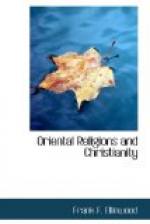Its bigoted founder gave the Koran as the sufficient guide for all time. It arrested the world’s progress as far as its power extended. Very different was the spirit of Judaism. “It distinctly disclaimed both finality and completeness. Every part of the Mosaic religion had a forward look, and was designed to leave the mind in an attitude of expectation.”
Mohammedanism, in claiming to be the one religion for all men and all time, is convicted of absurdity and imposture by its failures; by the retrograde which marks its whole history in Western Asia. As a universal religion it has been tried and found wanting.]
[Footnote 114: It has been claimed that the spread of Mohammedanism in India is far more rapid than that of Christianity. If this were true in point of fact, it would be significant; for India under British rule furnishes a fair field for such a contest. But it so happens that there, where Islam holds no sword of conquest, and no arbitrary power to compel the faith of men, its growth is very slow, it only keeps pace with the general increase of the population. It cannot compare with the advancement of Christianity. I subjoin an extract from Sir W. Hunter’s paper in the Nineteenth Century for July, 1888:
“The official census, notwithstanding its obscurities of classification and the disturbing effects of the famine of 1877, attests the rapid increase of the Christian population. So far as these disturbing influences allow of an inference for all British India, the normal rate of increase among the general population was about 8 per cent, from 1872 to 1881, while the actual rate of the Christian population was over 30 per cent. But, taking the lieutenant-governorship of Bengal as the greatest province outside the famine area of 1877, and for whose population, amounting to one-third of the whole of British India, really comparable statistics exist, the census results are clear. The general population increased in the nine years preceding 1881 at the rate of 10.89 per cent., the Mohammedans at the rate of 10.96 per cent., the Hindus at some undetermined rate below 13.64 per cent., Christians of all races at the rate of 40.71 per cent., and the native Christians at the rate of 64.07 per cent.”]
[Footnote 115: Leaves from an Egyptian Note-book.]
[Footnote 116: Christianity, Islam, and the Negro Race, p. 241.]
[Footnote 117: For the full text of the letter to the Standard, see Church Missionary Intelligencer, December, 1888.]
[Footnote 118: Church Missionary Intelligencer, 1887, p. 653.]
[Footnote 119: See Church Missionary Intelligencer, April, 1888.]
[Footnote 120: Over against Canon Taylor’s glowing accounts of this broad and gentle charity we may place the testimony of Palgrave in regard to the remorseless rapacity practised by the Wahabees upon the Shiyaees of Persia while passing through their territory in their pilgrimages to a common shrine. He tells us that “forty gold tomans were fixed as the claim of the Wahabee treasury on every Persian pilgrim for his passage through R’ad, and forty more for a safe conduct through the rest of the empire—eighty in all....




